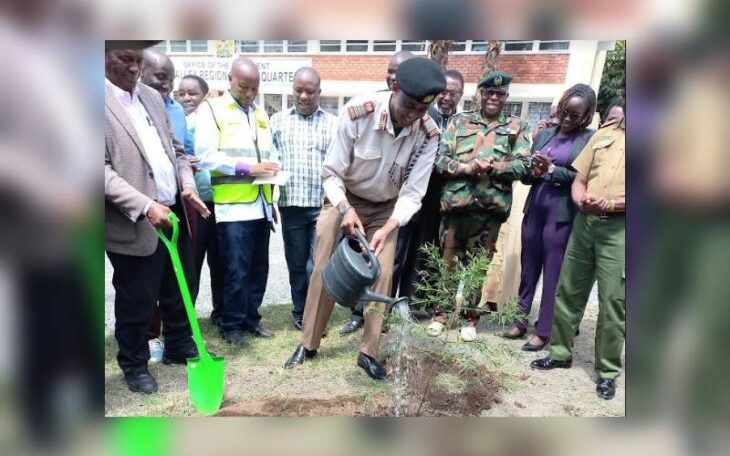NAKURU, Kenya, Dec 16 – Rift Valley Regional Commissioner Maalim Mohammed has urged citizens to make tree planting an integral part of every ceremony to achieve the 15 billion trees target set by the head of State in his Jamhuri day address.
Mr Maalim noted that with the current shift in weather patterns, it was imperative to take drastic steps to reverse the trend.
The administrator indicated that with the increasing negative consequences of climate change, including drought, flooding, rise in surface temperatures, famine and others, Kenyans’ short-term actions now will influence the direction the country takes for generations to come.
Mr Maalim spoke at his office in Nakuru when he rolled out a tree planting campaign in 14 counties within Rift Valley dubbed ‘Tree Growing Restoration Campaign, also known as ‘Greening Programme’.
While indicating that the best time to plant trees is now, Mr Maalim revealed that the campaign had brought on board National Government Administrative Officers (NGAO), Kenya Forest Service (KFS), Ministry of Education (MOE), religious institutions, Kenya National Highways Authority (KENHA), Kenya Urban Roads Authority (KURA) and Kenya Rural Roads Authority (KERRA).
“Conserving our environment requires such partnerships because through combined efforts we can move and change the world. When you move alone, you stumble,” said the administrator.
He stated that the Tree Growing Restoration and Greening Programme was in compliance with President William Ruto’s government plan to plant fifteen billion trees by 2030.
Mr Maalim said that the 14 County Commissioners had been instructed that the tree planting exercise should not be restricted to the water towers but should be a nationwide affair.
“The Government headed by Dr Ruto is concerned about climate change and its impact on Kenya generally and our arid and semi-arid regions in particular. That is why the head of state has directed that a long-term and sustainable solution be put in place, including greening the country to more than 30 percent of tree cover by 2030.
Additionally, the government will secure and protect public forests, and rehabilitate and restore all degraded water towers and other forest ecosystems across the country,” the Regional Commissioner said.
While disclosing that of the 59.2 million hectares’ land area in Kenya, only 5.2 million hectares are under forest cover the administrator said the programme will be seeking to tag the 5 million pupils in the region to plant at least 10 million trees within their learning institutions.
He urged Governors in the region to facilitate more discussions to achieve parity in tree cover across the counties by using peer-to-peer learning and exchange of information.
Mr Maalim revealed that the region had 6.5 million high-quality tree seeds produced by the Kenya Forestry Research Institute, while an additional 20 million seeds were being held in private nurseries.
The Regional Commissioner indicated that Rift Valley had an average forest cover of 14.6 per cent with Elgeyo Marakwet accounting for the highest at 37 per cent followed by Baringo at 25 per cent, Kericho at 23.5 per cent, Nandi 16.8 per cent, Narok 16.6 per cent and Trans Nzoia at 16.1 per cent.
Others are Samburu at 12.8 per cent, Bomet 12.7 per cent, Nakuru 9.2 per cent, West Pokot 8.3 per cent, Uasin Gishu 7.5 per cent, Kajiado 7.1 per cent, with Laikipia and Turkana trailing at 6.7 per cent and 4.06 per cent respectively.
He further commended some schools for taking a step further towards environmental conservation by establishing tree nurseries for learning purposes and financial benefits.
“Such gestures not only conserve the environment but also cushion the institutions against financial challenges,” he remarked.
He assured stakeholders that steps would be taken to ensure the trees planted are well taken care of and government would not hesitate to deal firmly with anyone destroying the seedlings.
He singled out herders who graze their animals in the forest, open fields and within estates that they would be prosecuted for allowing their animals to destroy the trees.
Chiefs have a target to plant 3,000 trees in their locations monthly and are under instructions to ensure they talk about tree planting in each of their barazas.
The RC urged stakeholders to identify different ways in which the target can be reached including planting trees equivalent to one’s age, employing adopt a tree for every person and engaging youth under the “trees for jobs” initiative.
Want to send us a story? Contact Shahidi News Tel: +254115512797 (Mobile & WhatsApp)


